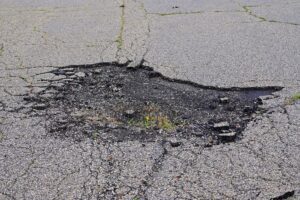Asphalt, a substance resembling tar that hardens into a cement-like finish, makes for an ideal pavement material for commercial property owners. For durable and beautiful results, you cannot go wrong with choosing asphalt for your next paving project. While asphalt can last for 10 to 20 years, different factors can impact the lifespan of your pavement.
Weather, seal coating treatment, and proper maintenance may affect whether your pavement endures wear and tear well. Different types of damage can arise for a number of reasons. Read on to learn about four ways that asphalt can sustain damage in order to prevent or repair these structural pavement concerns.

Raveling
Raveling refers to the disintegration of the agents within the asphalt over time. This makes the elements of the material separate, and you can see loose rocks and gravel that reveal the breaking down of the pavement. These particles can dislodge, creating a safety hazard that may harm vehicles or cause pedestrians to trip.
This phenomenon occurs because the binder keeping the asphalt’s agents weakens over time. Weakening can occur more quickly when the pavement is exposed to harsh weather conditions and heavy traffic. Poor paving during installation may also lead to raveling.
A paving contractor can remove and replace pavement damaged in this way. You can reduce the risk of this damage though when you practice good maintenance and upkeep.
Potholes
A pothole is a round hole in the pavement where the asphalt has chipped away. Driving over a pothole can seriously endanger a car, so you should patch this type of asphalt damage promptly. Consult a paving expert to learn the extent of repair work needed for this problem.
Potholes form when another existing problem, like a weak pavement structure or a smaller crack, worsens. So do not ignore even small structural concerns with your pavement if you want to avoid significant damage.
Cracks
A crack refers to a splitting of the otherwise smooth and seamless asphalt pavement. But there are many types of cracks that can form in your pavement. For instance, fatigue cracking, also known as alligator cracking, leaves a scaly-looking patch of damage that stems from poor installation or a too-thin layer of asphalt.
You can also see longitudinal cracking parallel to the centerline of the pavement, edge cracking near the perimeter of the pavement, and slippage cracking that occurs when poorly mixed asphalt experiences pressure or forces from traffic. The necessary repair work will depend on the extent of the cracking damage. Prevent cracks with seal coating and adequate installation from a paving expert.
Upheavals and Depressions
You might see a depression in the asphalt due to a pothole, but you can see sinking in the asphalt due to settlement beneath the pavement too. If the inner layers of the pavement do not lay properly, shifting in the soil under the pavement can reflect on the asphalt’s surface.
The pavement can see a swelling above the asphalt too, known as an upheaval. This comes from upward expansion beneath the pavement, which may happen due to weather conditions like frost.
You will need to replace this type of damaged pavement. Proper installation and construction in the first place can reduce the risk of these structural concerns.
